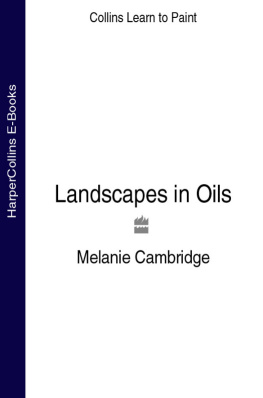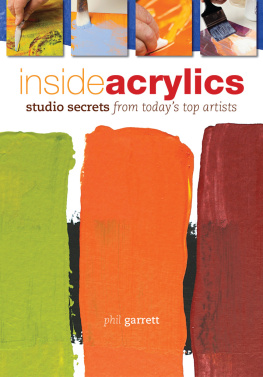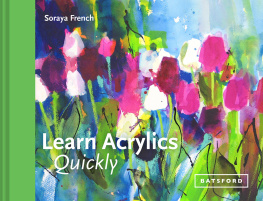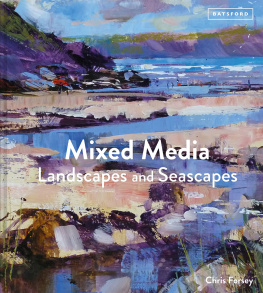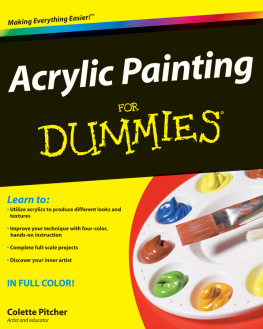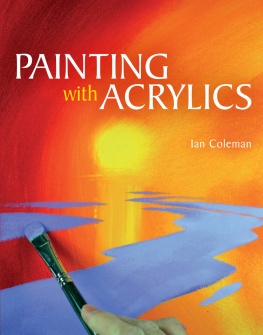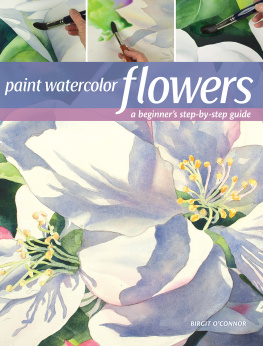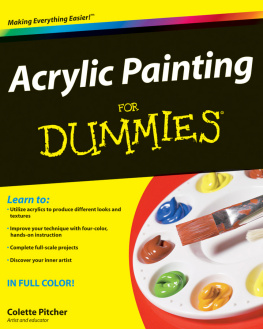
Australia
HarperCollins Publishers (Australia) Pty. Ltd.
Level 13, 201 Elizabeth Street
Sydney, NSW 2000, Australia
www.harpercollins.com.au
Canada
HarperCollins Canada
2 Bloor Street East - 20th Floor
Toronto, ON, M4W, 1A8, Canada
www.harpercollins.ca
New Zealand
HarperCollins Publishers (New Zealand) Limited
P.O. Box 1
Auckland, New Zealand
www.harpercollins.co.nz
United Kingdom
HarperCollins Publishers Ltd.
1 London Bridge Street
London SE1 9GF
www.harpercollins.co.uk
United States
HarperCollins Publishers Inc.
195 Broadway
New York, NY 10007
www.harpercollins.com
A s a beginner it can be very tempting to go down to your local art shop and buy a whole range of expensive materials and colours. However, the more materials you have, the more there are to master. A basic palette of eight colours, several brushes and some acrylic paper will be fine to begin with.
Painting surfaces Acrylic paints can be used on any non-shiny, non-oily surface. Acrylic coated paper is probably one of the best and cheapest options but heavyweight watercolour paper, canvas, canvas boards and even hardboard can be used, but prime the smooth side with at least two coats of acrylic primer first. Unfortunately, once dry, acrylics also cling particularly well to clothing, carpets and furnishings, so take care to wipe up any marks whilst they are still wet!
Paints Acrylic paints usually come in two quality grades, student quality such as Daler-Rowneys System 3, ideal for beginners, or artist quality ranges such as Cryla. The paints come in tubes of 75 ml or pots of 250 ml or larger. The tubes will be fine to begin with, but buy a 250 ml pot of white paint. To mix paler colours you will add white rather than just thinning them with water, and therefore you tend to use more white than any other colour. My recommended basic palette is: Ultramarine, Coeruleum, Cadmium Orange, Crimson, Sap Green, Lemon Yellow, Raw Sienna, Burnt Sienna and Titanium White.
Brushes There are several ranges of brushes designed specifically for acrylic paints. These are nylon and have more spring than a watercolour brush. I recommend that you start with two acrylic brushes and one watercolour brush. Buy a No.12 round watercolour wash brush, a 12 mm short flat acrylic brush and a No.4 round acrylic detail brush. The higher the number, the larger the brush.
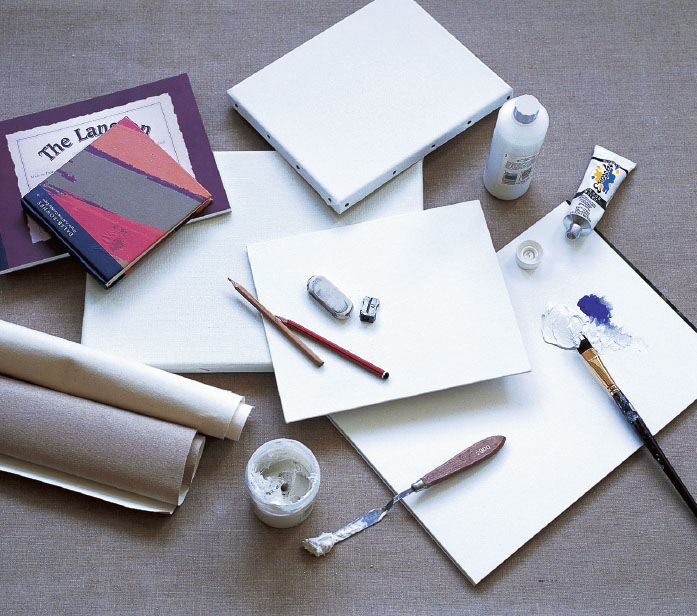
A selection of painting surfaces together with Texture Paste and mediums used in this book.
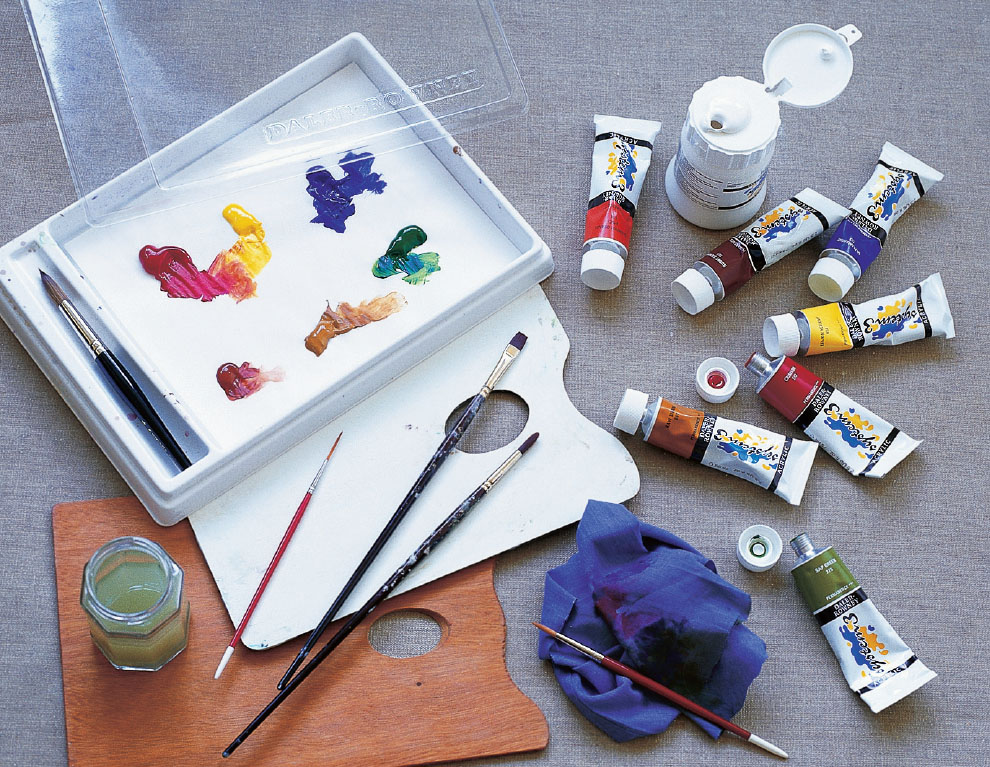
Acrylic colours laid out on a stay-wet palette ready for use, together with brushes and separate mixing palettes.
Mediums and Texture Paste There are various additives available for acrylic paints. These can be blended with your individual colours before being used in a painting. I recommend the following, which I have used in the book. Pearlescent Medium usually comes in a tube and has the same consistency as acrylic paint. It is most effective when mixed with a little acrylic colour to create a metallic version of that colour. Gloss Medium is a thin, milky substance that can be used to create a transluscent glaze. Texture Paste is used to increase the bulk of acrylic paint, enabling you to produce a very textured finish.
The stay-wet palette Acrylic paints can dry very quickly if they are simply squeezed onto an empty palette, so to prevent this I suggest you use two different palettes: a stay-wet palette on which to lay out your colours, and a separate plastic or melamine palette on which to mix your colours. The stay-wet palette is essentially a shallow tray with a lid. Place several sheets of absorbent paper such as kitchen towel in the bottom of the tray, then dampen this surface with a water sprayer. Next place a single sheet of baking parchment over the top and lay out your colours on this. By keeping the tray damp with the occasional spray of water and sealing with the lid when not in use, the paint should stay useable for several days. The paper surface is not ideal for mixing on as it tears easily, so use your second palette for mixing. The paint will dry out as you work, but the palette can be cleaned at the end of each painting session by running under a tap and rubbing gently with a metal pan scrubber.
Other items The following items will also come in useful: a water jar and small water sprayer, palette knife for mixing colours and working with Texture Paste, plenty of rags for wiping brushes and cleaning up, a soft 2B pencil, sketchbook and eraser.
When you start to paint buildings it is helpful to think of them as simple shapes. All buildings are basically box shapes (similar to the cube ) so breaking each building down into a number of simple blocks will help you to start painting buildings with confidence.
Fishermans cottage
See how I have simplified this fishermans cottage into two shapes, a box for the cottage and a triangular lid for the roof. Try to imagine each building you paint as separate blocks.
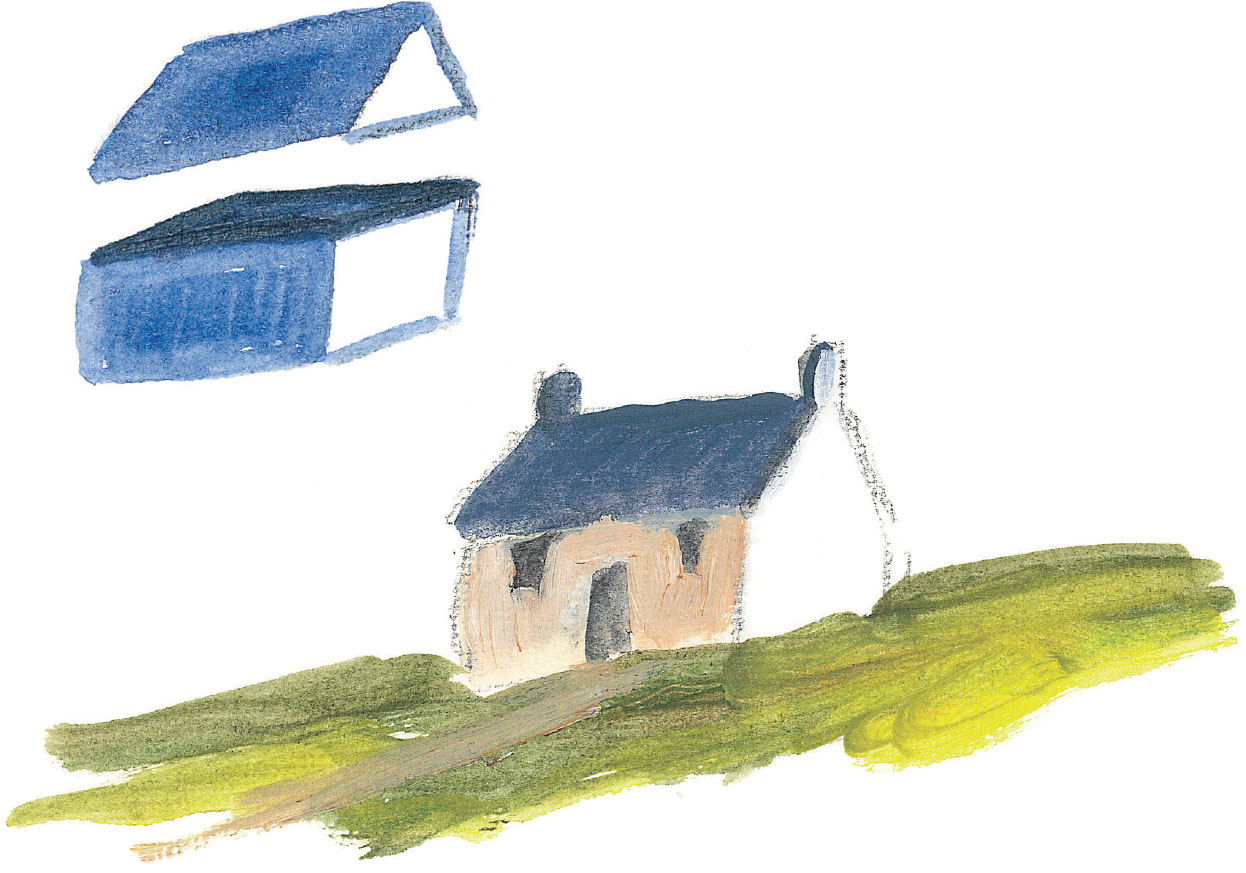
For this cottage, I began by drawing in the adjacent box shapes. The dark roof and chimneys are Ultramarine and Burnt Sienna, as are the windows and doorway. Finally, the cottage is placed on a grassy meadow (mix Lemon Yellow and Coeruleum) before adding a simple path with Raw Sienna and white.
Buildings in silhouette
Another way to simplify buildings, even a whole row of houses, is to paint them in silhouette. The lack of details on silhouetted buildings also helps them to merge into the background, making this a useful approach when trying to create more depth in your paintings.

When painting these buildings, you need to concentrate on getting the line of roofs right. Dont forget to add the chimneys!
Simple perspective
When we look at objects, lines above our eye level, such as the roof on a building, appear to angle downwards into the distance towards the level of our eyes, whereas items below this line, such as a road or footpath, appear to move upwards. The effect is the same in a painting, except that the eye-line is replaced by the horizon line.

In this diagram I have put in a single horizon line. See how the roof of the house (above the horizon) falls slowly downwards to a vanishing point in the far distance. Similarly the sides of the box which is below the horizon are angled upwards to a different vanishing point.
Lines below the horizon angle upwards, lines above angle downwards.
Pink cottages
These cottages are similar to the fishermans cottage . See how to begin with I have broken them down into a simple oblong with a roof. Windows and doorways are added later.




